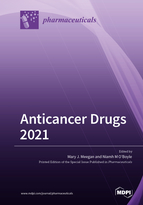Anticancer Drugs 2021
A special issue of Pharmaceuticals (ISSN 1424-8247). This special issue belongs to the section "Medicinal Chemistry".
Deadline for manuscript submissions: closed (31 October 2021) | Viewed by 87057
Special Issue Editors
Interests: anticancer drug design; breast cancer; novel antioestrogens; tubulin targeting agents; azetidinones; antioestrogen–drug conjugates; oestrogen receptor; Burkitt's lymphoma; chronic lymphocytic leukaemia
Special Issues, Collections and Topics in MDPI journals
Interests: anticancer drug design; tubulin targeting agents; novel antiestrogens; cancer immunotherapy; triple negative breast cancer; Chronic Lymphocytic Leukaemia; colorectal cancer; pancreatic cancer; designed multiple ligands
Special Issues, Collections and Topics in MDPI journals
Special Issue Information
Dear Colleagues,
The transition from cytotoxic chemotherapy to targeted cancer drug discovery and development has resulted in an increasing number of successful molecular therapies for cancer treatment. Continued research on the design of effective oncology drugs for application in chemotherapy has improved our understanding of the mechanism of action of these drugs, expanded their activity/function spectrum, and opened new potential applications for improved treatments. The availability of new effective oncology drugs is encouraging. The FDA approved eight drugs for orphan cancer indications in 2017 and 12 cancer drugs (26% of the total approvals), including two landmark approvals to the first CART cell therapies. The IDH2 inhibitor enasidenib is also noteworthy, demonstrating that drugs target cancer cells by blocking cancer-specific metabolic pathways. However, despite intense efforts, only a few effective therapies have emerged, and oncology drug development remains challenging; combination therapy may the future for oncology patients. To achieve a more comprehensive understanding of these activities, the journal Pharmaceuticals now invites you to contribute review or original research articles covering the different facets of anticancer drug research, which will be published as a Special Issue on “Anticancer Drugs”. The focus of this Special Issue is on the design, synthesis, and molecular mechanism of action of novel antitumor drugs and on the relationship between the chemical structure and biochemical reactivity of the molecules. This issue will also provide an understanding of the biologic and genotypic context in which targets are selected for oncology drug discovery, thus allowing rationalization of the activity of these drugs and guiding the design of more effective agents.
Areas of interest include, but are not limited to:
- Anticancer drugs acting via reactive oxygen species
- Antitumor drugs targeting tubulin and microtubules
- Prodrug-based anticancer agents
- PDEPT (polymer-directed enzyme prodrug therapy)
- Polymer–protein conjugates
- Alkylating agents
- Nuclear receptor antagonists
- Cancer immunotherapy
- Antibody–drug conjugates
- Inhibitors of kinases relevant to cancer: tyrosine kinases, serine–threonine kinases
- Drugs acting on apoptotic signaling pathways
- HSP-90 inhibitors
- PARP inhibitors
- Conjugate and hybrid drugs; dual-acting anticancer drugs
- Photodynamic therapy
- Anti-angiogenic therapy
- Drugs targeting mutant p53
- Cancer precision medicine
- Metabolism-modulating anti-cancer drugs
Prof. Dr. Mary J Meegan
Dr. Niamh M O’Boyle
Guest Editors
Manuscript Submission Information
Manuscripts should be submitted online at www.mdpi.com by registering and logging in to this website. Once you are registered, click here to go to the submission form. Manuscripts can be submitted until the deadline. All submissions that pass pre-check are peer-reviewed. Accepted papers will be published continuously in the journal (as soon as accepted) and will be listed together on the special issue website. Research articles, review articles as well as short communications are invited. For planned papers, a title and short abstract (about 100 words) can be sent to the Editorial Office for announcement on this website.
Submitted manuscripts should not have been published previously, nor be under consideration for publication elsewhere (except conference proceedings papers). All manuscripts are thoroughly refereed through a single-blind peer-review process. A guide for authors and other relevant information for submission of manuscripts is available on the Instructions for Authors page. Pharmaceuticals is an international peer-reviewed open access monthly journal published by MDPI.
Please visit the Instructions for Authors page before submitting a manuscript. The Article Processing Charge (APC) for publication in this open access journal is 2900 CHF (Swiss Francs). Submitted papers should be well formatted and use good English. Authors may use MDPI's English editing service prior to publication or during author revisions.
Keywords
- Anticancer drugs
- Cancer drug design
- Cancer immunotherapy
- Conjugate and Hybrid drugs








